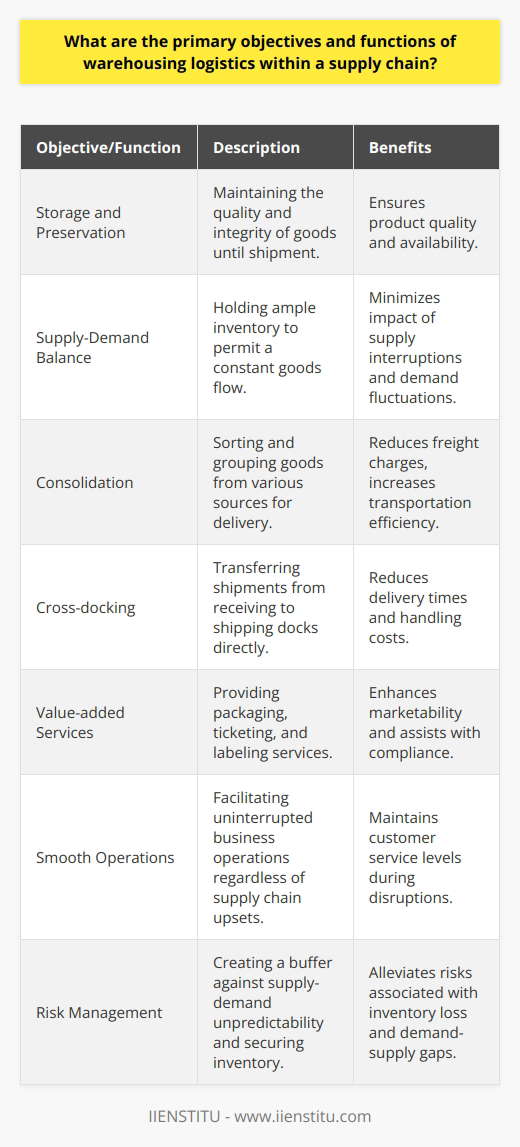
Introduction
I still remember the first time I walked into a massive distribution center. The sheer scale of operations, the synchronized movements of forklifts, and the constant hum of activity left me in awe. It was then that I truly grasped the importance of logistics in our daily lives. As someone who has spent years navigating the complexities of supply chain management, I've come to appreciate the intricate dance that ensures goods move seamlessly from manufacturers to consumers.
Introduction
System Approach to Logistics Management
Warehousing and Material Storage
Load Unitizing and Material Handling
Conclusion
Over the years, I've learned that adopting a system approach to logistics isn't just beneficial—it's essential. This approach involves meticulously planning, organizing, and managing the movement of goods and services from their point of origin to their point of consumption. By viewing logistics as an interconnected system, we can optimize every facet, from warehousing to transportation, ensuring efficiency, cost-effectiveness, and safety.
In this article, I'll delve deep into the components of this system approach. We'll explore warehousing and material storage, load unitizing and material handling, site selection and network planning, and more. Along the way, I'll share personal experiences and insights, hoping to shed light on the significance of viewing logistics through a systemic lens.
The System Approach to Logistics Management
At its core, the system approach is about seeing the bigger picture. Instead of viewing each component of the supply and chain management separately, we recognize that every element is interconnected. This holistic perspective ensures that decisions in one area positively impact the entire chain.
In my early days, I witnessed companies operating in silos. The procurement team focused solely on getting the best prices, while the logistics team grappled with storage issues due to unexpected bulk purchases. This lack of coordination often led to increased costs and inefficiencies.
By adopting a system approach, companies can:
Enhance Efficiency: Streamline operations by coordinating activities.
Reduce Costs: Identify areas where resources can be optimized.
Improve Safety: Ensure all processes adhere to safety standards.
Understanding the logistics meaning in this context is crucial. It's not just about moving goods but about strategically managing every step to add value.
Warehousing and Material Storage
One of the pivotal components of the logistics system is warehousing. I recall a project where we had to revamp an old warehouse. The space was vast but underutilized. By rethinking the layout and adopting modern storage solutions, we increased storage capacity by 30% without expanding the footprint.
Comprehensive Definition Of Logistics And İts Role İn Business
System Approach To Logistics Management For Packaging Handling
Key factors to consider in warehousing include:
1- Location: Proximity to major transportation hubs reduces transit times.
2- Layout Design: Efficient designs facilitate faster picking and packing.
3- Technology Integration: Utilizing Warehouse Management Systems (WMS) for real-time inventory tracking.
It's essential to remember that warehousing isn't just about storing goods; it's about optimizing space and processes to enhance the overall management chain supply.
Load Unitizing and Material Handling
Load unitizing involves consolidating products into unit loads, making them easier to handle and transport. Proper material handling ensures that goods are moved safely and efficiently within the warehouse and during transit.
From personal experience, investing in quality material handling equipment can make a significant difference. For instance:
Forklifts and Pallet Jacks: Essential for moving heavy loads.
Conveyors: Streamline movement within the warehouse.
Automated Guided Vehicles (AGVs): Enhance efficiency in large facilities.
By focusing on load unitizing and material handling, businesses can reduce damage, improve safety, and optimize operations.
Site Selection and Network Planning
Choosing the right locations for warehouses and distribution centers is a strategic decision that impacts the entire chain of supply management. Factors to consider include:
Accessibility: Close proximity to highways, ports, and railways.
Labor Market: Availability of skilled workers.
Infrastructure: Quality of roads, utilities, and communication networks.
During a network planning project, we used advanced modeling to identify optimal locations. This allowed us to reduce transportation costs and improve delivery times significantly.
Order Picking and Filling
Efficient order picking and filling processes are vital for customer satisfaction. I've seen warehouses where disorganized systems led to delayed shipments and unhappy customers. Implementing systematic picking strategies, such as:
Zone Picking
Batch Picking
Wave Picking
can improve accuracy and speed. Utilizing technology like barcode scanners and voice-directed picking systems also enhances efficiency.
Dispatch Documentation
Accurate and timely dispatch documentation is crucial. It not only ensures compliance with regulations but also facilitates smooth customs clearance and delivery. Important documents include:
Bills of Lading
Packing Lists
Invoices
I once had a shipment delayed at a port due to incomplete documentation. It was a hard lesson on the importance of meticulous paperwork in logistics.
Integrating Technology in Logistics
Technology plays a transformative role in modern logistics. Implementing a Transport Management System (TMS) can revolutionize operations by:
The key to successful logistics management is a systematic approach to warehouse, storage, and more.
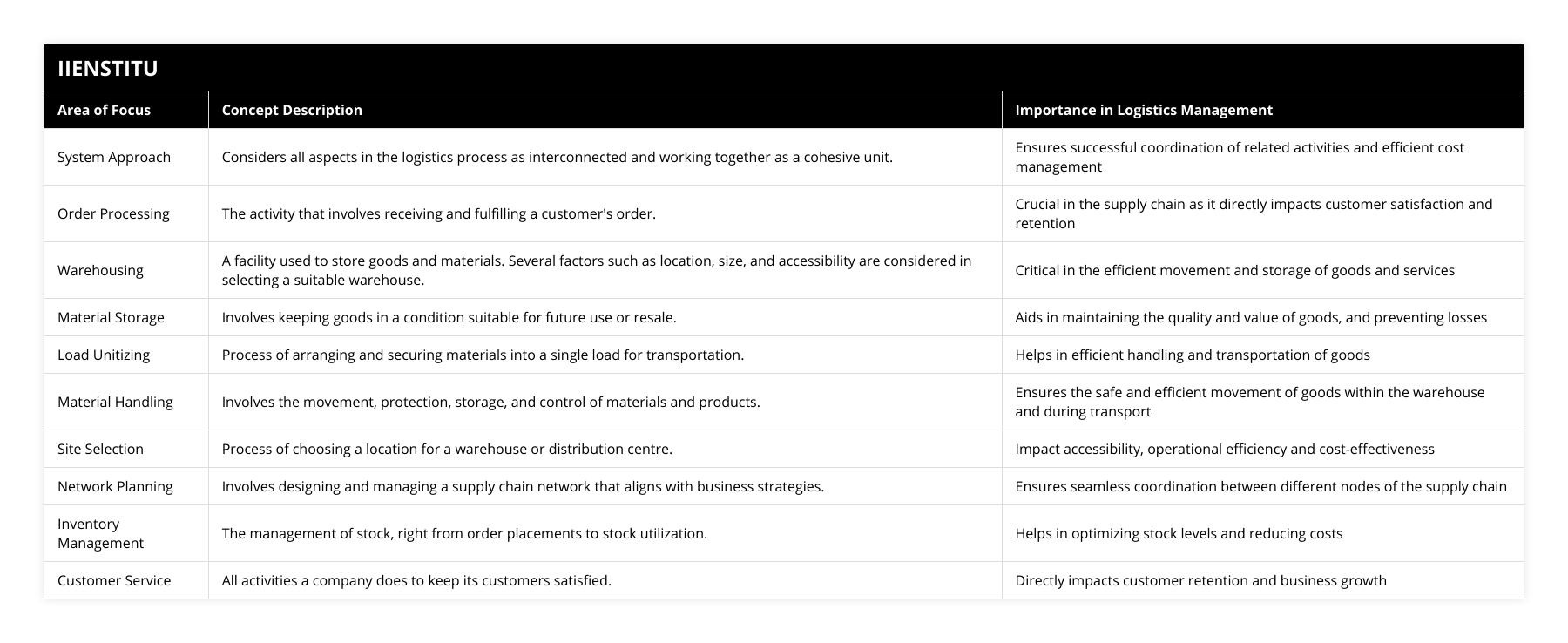
Optimizing Routes: Reducing fuel consumption and transit times.
Tracking Shipments: Providing real-time updates.
Automating Processes: Reducing manual errors.
In one of our projects, integrating a TMS led to a 20% reduction in operating costs. Embracing technology is no longer optional but a necessity in today's competitive environment.
Supply Chain Activities and Coordination
Effective logistics management is intertwined with broader supply chain activities. Coordination between procurement, production, and distribution ensures that goods flow smoothly from suppliers to customers.
Key activities include:
Demand Forecasting
Inventory Management
Supplier Relationship Management
By aligning these activities, companies can reduce costs, improve service levels, and enhance operational efficiency.
SCM Management: Beyond Logistics
While logistics focuses on moving and storing goods, SCM management encompasses the entire process from raw material acquisition to product delivery. It includes:
Procurement
Production Planning
Quality Control
Customer Service
Understanding the nuances of supply chain management management is crucial for businesses aiming to stay ahead in the market. It's about creating a seamless flow of information, products, and finances.
Challenges in Chain of Supply Management
Managing the chain of supply management comes with its challenges:
Globalization: Navigating international regulations and cultural differences.
Technological Advances: Keeping up with rapid technological changes.
Customer Expectations: Meeting demands for faster and more flexible deliveries.
Sustainability: Incorporating eco-friendly practices.
Overcoming these challenges requires strategic planning, continuous learning, and adaptability.
Tips to Optimize Supply Chain Management Processes
Based on my experiences, here are some practical tips to optimize supply chain management process tips:
1- Leverage Technology: Use advanced software for planning and execution.
2- Enhance Collaboration: Work closely with suppliers and customers.
3- Invest in Training: Equip your team with the latest skills.
4- Embrace Flexibility: Be ready to adapt to market changes.
5- Focus on Sustainability: Implement eco-friendly practices.
By implementing these strategies, businesses can enhance efficiency and stay competitive.
The Human Element in Logistics
While technology and systems are essential, the human element remains irreplaceable. I've always believed that a motivated and skilled team is the backbone of successful logistics operations.
Training: Regular training ensures the team stays updated.
Communication: Open channels facilitate better coordination.
Recognition: Acknowledging efforts boosts morale.
At one of our facilities, implementing a staff recognition program led to a noticeable increase in productivity and a decrease in turnover rates.
Conclusion
The system approach to logistics management emphasizes the interconnectedness of all supply chain components. By viewing logistics as a cohesive system, businesses can improve efficiency, reduce costs, and enhance customer satisfaction.
It's about more than just moving goods; it's about strategic planning, coordination, and continuous improvement. As the logistics landscape evolves, embracing a systemic approach will be key to navigating challenges and seizing opportunities.
References
1- Ballou, R. H. (2004). Business Logistics/Supply Chain Management. Pearson Prentice Hall.
2- Chopra, S., & Meindl, P. (2016). Supply Chain Management: Strategy, Planning, and Operation. Pearson.
3- Rushton, A., Croucher, P., & Baker, P. (2017). The Handbook of Logistics and Distribution Management. Kogan Page.
4- Bowersox, D. J., Closs, D. J., & Cooper, M. B. (2013). Supply Chain Logistics Management. McGraw-Hill.
Frequently Asked Questions
What are the key components of a system approach to logistics management?
Logistics management is an integral part of any business. It involves the planning, organizing, and controlling the flow of goods, services, and information throughout the supply chain. A system approach to logistics management focuses on the interconnections between different elements of the supply chain, including the physical flow of goods, the financial flow, the flow of information, and the flow of people. This article will discuss the critical components of a system approach to logistics management.
The first component of a system approach to logistics management is the physical flow of goods. This includes the transportation of goods, the storage of goods, and the handling of goods. This component involves the efficient and timely delivery of goods from the origin point to the destination's end. This requires an understanding of the physical requirements of the supply chain, such as the type of transportation rneededand the methods of handling and packaging.
The financial flow is the second component of a logistics management system approach. This involves the management of cash flow, accounts receivable, and accounts payable. This component requires an understanding of the cost of goods, the cost of transportation, and the cost of handling, and packaging. It also requires understanding the financial instruments used to finance the supply chain, such as lines of credit and leasing agreements.
The third component of a logistics management system approach is information flow. This involves the gathering and dissemination of information throughout the supply chain. This includes the collection of customer orders, the tracking of inventory, and the monitoring of the performance of suppliers and other vendors. This component requires understanding the information systems and technologies used in the supply chain, such as Enterprise Resource Planning (ERP) systems, customer relationship management (CRM) systems, and warehouse management systems.
The fourth component of a logistics management system approach is the people flow. This involves the management of personnel and the recruitment of personnel. This component requires an understanding of the skills and qualifications needed for each position in the supply chain, as well as the methods of training and motivating personnel.
In conclusion, a system approach to logistics management focuses on the interconnections between different supply chain elements. The critical components of this system approach are the physical flow of goods, the financial flow, the flow of information, and the flow of people. Understanding how these components interact and affect each other is essential for effective supply chain management.
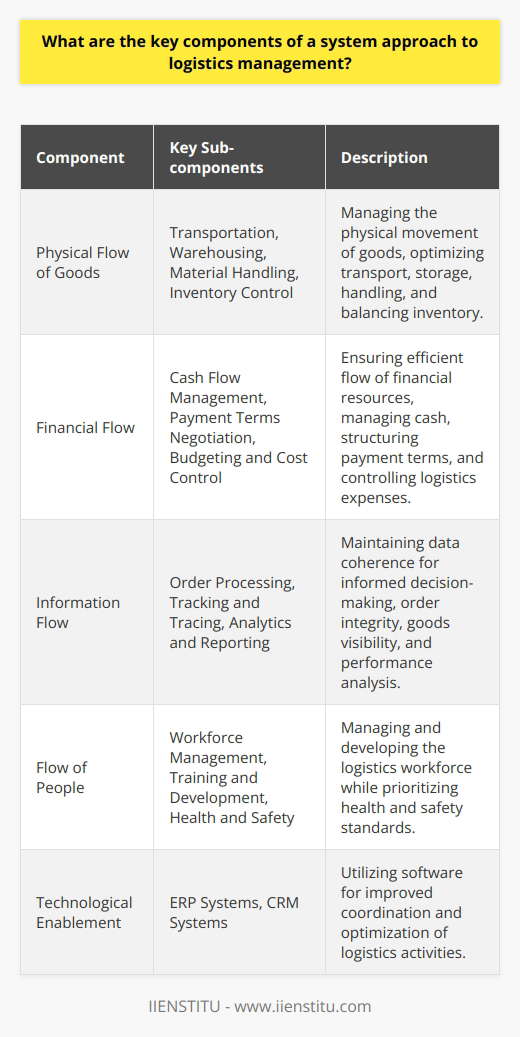
How can warehousing and material storage be optimized for efficiency?
Warehousing and material storage are essential components in the modern supply chain and can significantly determine any operation's efficiency. Consequently, it is necessary to understand and apply the best practices to optimize the efficiency of these operations.
First and foremost, it is essential to consider the layout of the warehouse and storage space. The form should be designed to facilitate the movement of goods logically and efficiently. This includes using space economically and creating a clear path for goods to be moved from one area to another. Additionally, the physical design of the warehouse should be optimized to maximize the amount of usable space and ensure that the flow of goods between different areas is not impeded.
Second, inventory management systems should be implemented to ensure that the suitable material is available in the right place at the right time. This includes tracking inventory levels and utilizing efficient methods to replenish stock. Additionally, it is essential to consider the use of automation and other advanced technologies to streamline the inventory management process.
Third, it is essential to consider using technology to optimize the warehouse and material storage process. This includes using sensors to monitor the environment, utilizing RFID systems to track items, and using automated guided vehicles (AGVs) to improve the efficiency of the material handling process. Additionally, it is essential to evaluate the use of predictive analytics and machine learning to anticipate future demand and optimize the storage space accordingly.
Finally, it is essential to consider using analytics and data-driven decision-making to make informed decisions regarding warehouse and material storage process optimization. This includes analyzing historical data to identify patterns and trends and utilizing predictive analytics to anticipate future trends. Additionally, using data can help identify opportunities for improvement and allow for the implementation of corrective action in a timely manner.
In conclusion, optimizing warehousing and material storage is an essential component of an efficient supply chain. By considering the best practices outlined in this article, organizations can ensure that their operations are optimized for maximum efficiency.
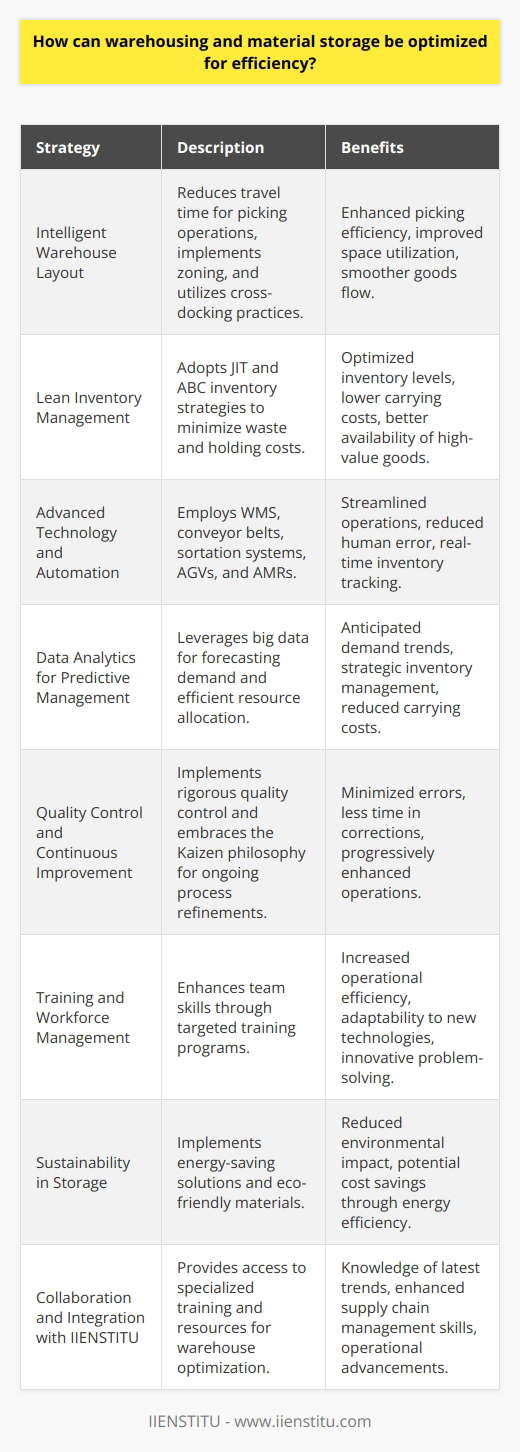
What are the benefits of load unitizing and material handling?
Load unitizing and material handling are essential elements of efficient supply chain management. The practice of unitizing and handling materials can bring several benefits to the overall operation of a supply chain.
One of the significant benefits of load unitizing is that it reduces the number of shipments required to move goods from one place to another. By consolidating multiple shipments into one, loading, transportation, and unloading costs can be significantly reduced. This, in turn, reduces the overall operational costs associated with the supply chain.
Load unitizing also helps reduce the risk of damaged goods in transit. By consolidating multiple shipments into one, the risk of goods being damaged during transit is significantly reduced. This is especially beneficial for fragile goods, as the risk of damage is minimized when goods are consolidated into a single load.
Material handling also offers several benefits to the supply chain. Using efficient material handling techniques, goods can be moved quickly and efficiently from one location to another. This helps reduce the overall time taken to move goods and save on labor costs. In addition, the use of proper material handling equipment can help to reduce the risk of accidents or injuries, which can lead to lower insurance costs.
Finally, load unitizing and material handling advantages extend to environmental protection. By reducing the number of individual shipments, the amount of emissions released into the atmosphere is significantly reduced. In addition, the use of proper material handling equipment can reduce energy consumption, leading to further reductions in emissions.
In conclusion, load unitizing and material handling offer several benefits to the overall operation of a supply chain. Supply chain operations can be significantly enhanced by reducing the number of individual shipments, reducing the risk of damage to goods, improving the efficiency of goods movement, and reducing energy consumption.
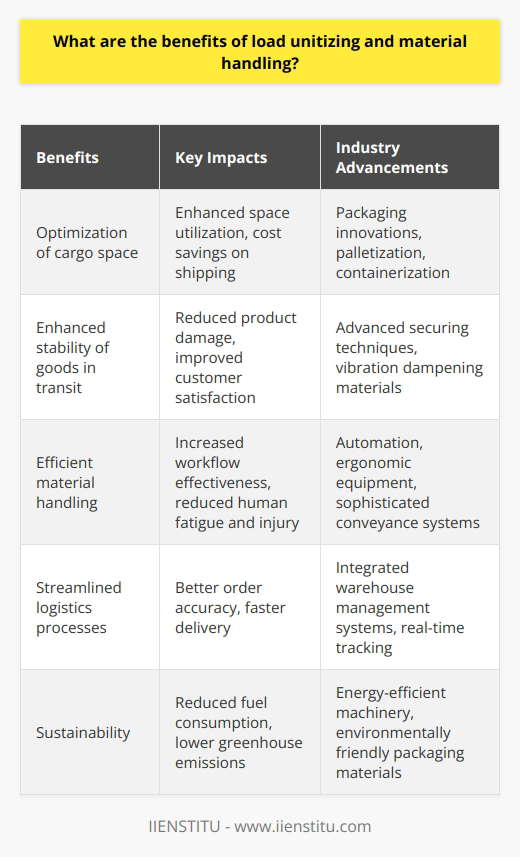
What is the role of logistics systems in managing the supply chain effectively?
Role of Logistics Systems in Supply Chain Management
Efficient Coordination and Management
The primary role of logistics systems in managing the supply chain effectively is to ensure efficient coordination and management of processes and resources. Logistics systems encompass transport, warehousing, inventory management, and information technology, which enable businesses to optimize their productivity and enhance competitiveness. By managing these crucial aspects, logistics systems facilitate smooth functioning across the entire supply chain network.
Reducing Operational Costs
Logistics systems help organizations reduce operational costs by streamlining processes and improving resource management. Through the optimization of transportation routes and methods, businesses can minimize fuel consumption, shorten delivery times, and reduce overall freight costs. Additionally, employing efficient warehousing practices and accurate inventory control can significantly lower storage and handling expenses.
Promoting Sustainability
Another essential role of logistics systems is promoting sustainability across the supply chain. By implementing eco-friendly transportation methods, reducing energy consumption in warehousing, and minimizing waste production, businesses can integrate green practices into their operations. Logistics systems can also aid in resource optimization and recycling initiatives, enabling organizations to fulfill their environmental responsibilities.
Enhancing Customer Satisfaction
Logistics systems contribute to enhancing customer satisfaction by ensuring timely deliveries, accurate order fulfillment, and reliable product availability. Effective information management within logistics systems allows businesses to predict demand accurately, preventing stockouts and delays in meeting customer needs. These efforts translate to higher customer satisfaction and increased brand loyalty.
Encouraging Scalability and Flexibility
A well-designed logistics system allows businesses to adapt to changing market conditions and scale their operations accordingly. This flexibility enables organizations to cater to the varying demands of customers and invest in potential growth areas. In addition, efficient logistics systems contribute to resilience against disruptions and help businesses maintain a consistent flow of goods, even during unforeseen circumstances.
In conclusion, logistics systems play an integral role in managing the supply chain effectively by promoting efficiency, reducing operational costs, encouraging sustainability, enhancing customer satisfaction, and fostering scalability and flexibility. By optimizing these critical aspects, logistics systems contribute significantly to the overall performance and success of organizations in a highly competitive global market.

How does the application of a systems approach improve the overall efficiency and effectiveness of logistics management?
Understanding Systems Approach
The application of a systems approach enhances the efficiency and effectiveness of logistics management by emphasizing the interdependence of various components within a logistics system. This methodology encourages a holistic perspective, taking into consideration how different elements affect each other and contribute to the system's overall performance.
Uncovering Systemic Issues
By analyzing a logistics system as a whole, managers can better identify the root causes of inefficiencies and make informed decisions to optimize the process. This helps to reduce the time and resources wasted on addressing symptoms rather than addressing the underlying problems, thus improving the overall efficiency and effectiveness of logistics management.
Facilitating Collaboration and Communication
A systems approach fosters increased collaboration and communication among internal and external stakeholders. It enables a better understanding of the roles and responsibilities of each party and facilitates the coordination and alignment of goals and objectives. This results in a more streamlined and effective logistics management process, ensuring that all parties are working towards a common objective.
Integrated Technology and Automation
Adopting a systems approach also allows logistics managers to capitalize on the advantages of integrated technology and automation solutions. By leveraging these tools, processes can be streamlined, human error can be reduced, and analytics can be utilized to support decision-making. This ultimately contributes to enhanced efficiency, cost-effectiveness, and a more competitive supply chain.
Continuous Improvement and Adaptability
One of the key benefits of applying a systems approach in logistics management is the emphasis on continuous improvement and adaptability. This encourages organizations to constantly re-assess their processes, identify opportunities for growth, and adapt to changes in the industry. This proactive mindset ensures that logistics management remains efficient and effective, even as the business environment evolves.
In conclusion, the application of a systems approach to logistics management significantly improves overall efficiency and effectiveness by promoting a holistic understanding of the process, facilitating communication and collaboration, harnessing technology and automation, and fostering continuous improvement and adaptability.

What factors should be considered when designing and implementing a warehousing and storage strategy for optimal logistics performance?
Key Factors in Warehousing and Storage Strategy
Asset Utilization and Space Optimization
When designing a warehousing and storage strategy, it is crucial to optimize space utilization and asset productivity. This can be achieved by ensuring proper product organization, employing innovative storage solutions, and maintaining efficient warehouse layouts that suit the business's inventory control objectives.
Inventory Management and Control
Effective inventory management is vital for logistics performance. To accomplish this, a storage strategy should consider factors including seasonality, demand fluctuations, and item-specific attributes. Implementing advanced inventory management techniques, such as just-in-time, barcode scanning, or RFID tagging, can aid in accuracy, visibility, and stock control.
Reconfigurability and Scalability
A well-designed warehousing and storage strategy includes the ability to respond to changing market demands and business growth. Considering factors like the ease of reconfiguration and scalability ensures long-term flexibility, reducing costs related to relocating facilities or investing in additional infrastructure.
Workflow Efficiency and Automation
To drive optimal logistics performance, a warehousing and storage strategy should facilitate efficient workflows for employees and include relevant automation technologies. Factors to consider include labor-saving technologies, such as automated guided vehicles, conveyor systems, and robotic material handling solutions, all of which can streamline processes and reduce errors.
Cost-effectiveness and Financial Viability
Cost control is vital in warehouse management, and a comprehensive storage strategy must ensure financial viability. To achieve this, careful planning of storage and retrieval systems, monitoring labor costs, and identifying opportunities for cost reduction are essential. This must be balanced with investments in technology to maintain competitiveness in the market.
Safety and Environmental Considerations
Finally, the ongoing safety of employees and adherence to environmental regulations must be considered in the warehousing and storage strategy design. This includes attention to ergonomics, hazard identification, and risk mitigation strategies; while also planning for sustainable practices like recycling or energy-efficient equipment.
In conclusion, designing and implementing a warehousing and storage strategy for optimal logistics performance requires a multifaceted approach that addresses asset utilization, inventory management, flexibility, workflow efficiency, cost-effectiveness, and safety and environmental considerations. By considering these factors, businesses can create efficient, sustainable, and cost-effective warehousing and storage solutions that meet their needs and drive overall success in the marketplace.

What is the significance of a systems approach in enhancing the coordination of different aspects of logistics management?
The Significance of a Systems Approach
A systems approach plays a critical role in enhancing the coordination of various aspects of logistics management. This holistic method ensures effective planning, implementation, and control of resources and processes to achieve optimal results for a company. By analyzing the interdependency of different logistics functions, it enables organizations to identify areas of improvement, streamline operations and enhance overall efficiency.
Interconnectivity and Collaboration
Using the systems approach, managers understand the importance of interconnectivity and collaboration between different logistics departments. By fostering communication, the approach breaks down silos, allowing for the sharing of crucial information and the efficient management of the supply chain. In turn, this results in improved visibility and control over key performance indicators such as delivery times, inventory levels, and order accuracy, helping businesses make better informed decisions.
Resource Optimization
One central aspect of the systems approach is resource optimization. By scrutinizing a company's operations and finding opportunities to consolidate and eliminate redundancies, the method enables businesses to allocate resources more effectively and intelligently. Consequently, organizations can reduce costs, increase productivity, and achieve higher levels of customer satisfaction through quicker response times and improved service quality.
Risk Assessment and Mitigation
The systems approach also aids in risk assessment and mitigation. By comprehensively examining the interconnected risks in a supply chain network, the approach supports the identification of potential bottlenecks, vulnerabilities, and disruptions. Consequently, companies can better prepare for unforeseen events by implementing appropriate contingency plans and risk management strategies, ensuring business continuity and minimizing downtime.
Continuous Improvement
Lastly, the systems approach fosters a continuous improvement culture within an organization. By methodically evaluating and monitoring performance, companies can identify areas of success and potential issues. This, in turn, enables the implementation of changes in a timely manner and encourages the ongoing evolution of operations. The end result is a more agile and adaptive logistics management process, capable of responding to changing market conditions, business objectives, and customer demands.
In conclusion, adopting a systems approach in logistics management enhances coordination, drives efficiency and provides organizations with the ability to identify and address potential issues proactively. Through interconnectivity, resource optimization, risk assessment, and continuous improvement, the method contributes to smarter decision-making and improved overall performance for businesses looking to compete in today's fast-paced and dynamic global market.
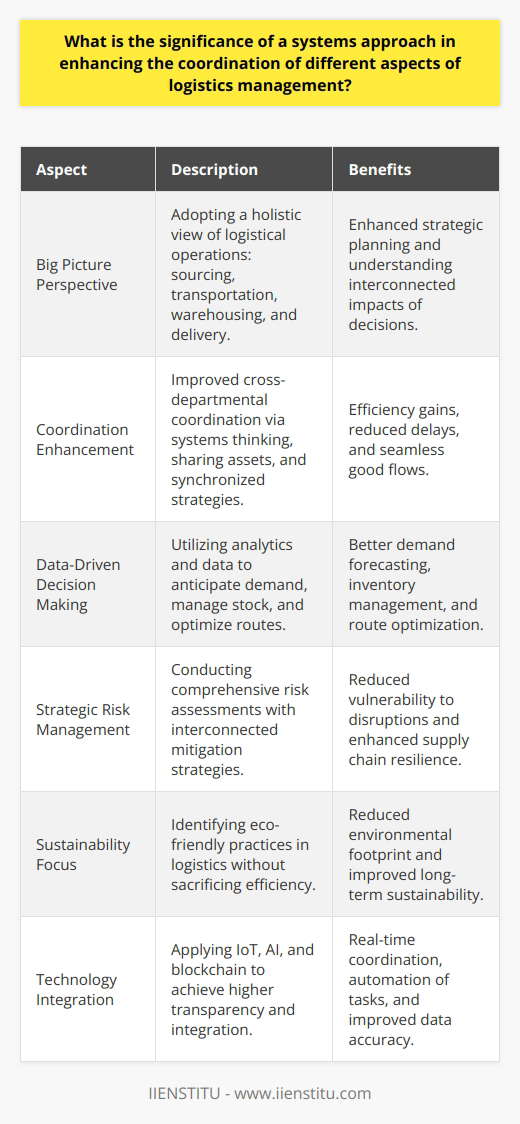
How do the key principles of warehousing and storage contribute to the overall effectiveness of a logistics system?
Efficient Warehousing and Storage
A successful logistics system relies on efficient warehousing and storage as critical components. Warehousing facilities provide space for stock consolidation, offering streamlined inventory management and cost reduction. These centralized locations enable quicker order fulfillment, ultimately leading to enhanced customer satisfaction.
Inventory Control and Management
Key principles of warehousing include effective inventory control and management, which enhance the overall logistics system. Maintaining accurate records, tracking stock levels, and implementing strategies such as just-in-time (JIT) delivery reduce lead times while minimizing costs. Moreover, inventory optimization prevents stock-outs and overstocking, ensuring that customer demands are met without unnecessary expense.
Optimized Layout and Design
A well-designed warehouse layout facilitates efficient material handling and storage. Adhering to the principles of warehouse design, such as proper space utilization and organized storage systems, allows for increased productivity and expedites order processing. Additionally, implementing modern technologies like automated storage and retrieval systems can improve warehouse operations and throughput.
Safety and Security
A safe and secure warehouse environment is vital for a logistics system's effectiveness. The implementation of safety policies, training programs, and risk assessment aids in preventing accidents and injuries. Furthermore, security measures such as access control and surveillance systems safeguard against theft and damage, ultimately protecting inventory and ensuring uninterrupted supply chain operations.
Integration with Logistics Network
An efficient warehousing and storage system is integrated into the broader logistics network, enhancing the overall effectiveness by streamlining information flow and promoting supply chain visibility. Electronic communication tools, such as warehouse management systems (WMS), enable real-time data exchange between warehouses, transport providers, and other supply chain partners. This integration fosters collaboration and coordination, resulting in improved flexibility, responsiveness, and cost control.
In conclusion, effective warehousing and storage play a vital role in a logistics system's success. Adherence to key principles such as inventory management, warehouse layout optimization, safety and security, and network integration ensures efficient operations while reducing costs. By focusing on these core aspects, a company can achieve a high-performing, cost-effective logistics system to meet customer demands and maintain a competitive edge in the market.
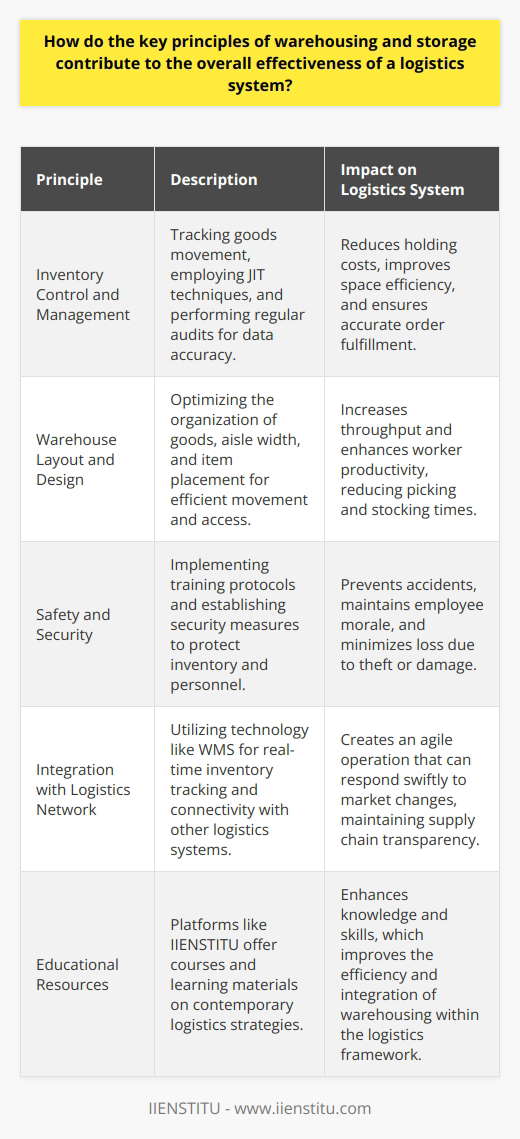
What role do the five warehouse management processes play in ensuring seamless flow of materials and goods within a logistics system?
Role of Warehouse Management Processes
Inventory Control:
Effective inventory control within a warehouse enables efficient management of materials and goods, which is vital for a seamless logistics system. It involves tracking items through their lifecycle, from receiving and stocking to picking and shipping, ensuring accuracy and preventing stock shortages or overages.
Order Picking:
Order picking, the process of selecting items from storage to fulfill customer orders, plays a critical role in the flow of materials and goods. An efficient order picking system minimizes errors, reduces order cycle times, and maintains a high level of customer satisfaction, ultimately leading to a seamless logistics operation.
Storage and Space Utilization:
Optimizing storage and space utilization within warehouses is crucial for effective materials and goods management. By implementing strategic storage layouts, including racking and shelving systems, warehouses can maximize their capacity, streamline material handling processes, and minimize bottlenecks that may disrupt the supply chain.
Warehouse Layout:
A well-planned warehouse layout contributes significantly to seamless logistics operations by facilitating the efficient flow of materials and goods. By considering factors such as product characteristics and handling requirements, a warehouse can be designed to minimize unnecessary movement, reduce congestion, and optimize the use of available space and resources.
Integration of Technology:
Incorporating advanced technology into warehouse management processes is essential for ensuring a smooth materials and goods flow within a logistics system. Technologies such as warehouse management systems, barcoding, and RFID systems enable real-time tracking, increase visibility and accuracy, and streamline various processes, leading to improved efficiency, cost savings, and overall better warehouse operations.
In conclusion, each of the five warehouse management processes plays a vital role in ensuring the seamless flow of materials and goods within a logistics system. By optimizing inventory control, order picking, storage and space utilization, warehouse layout, and the integration of technology, warehouses can achieve efficiencies, reduce errors, and maintain a high level of customer satisfaction, ultimately contributing to a more effective logistics operation.
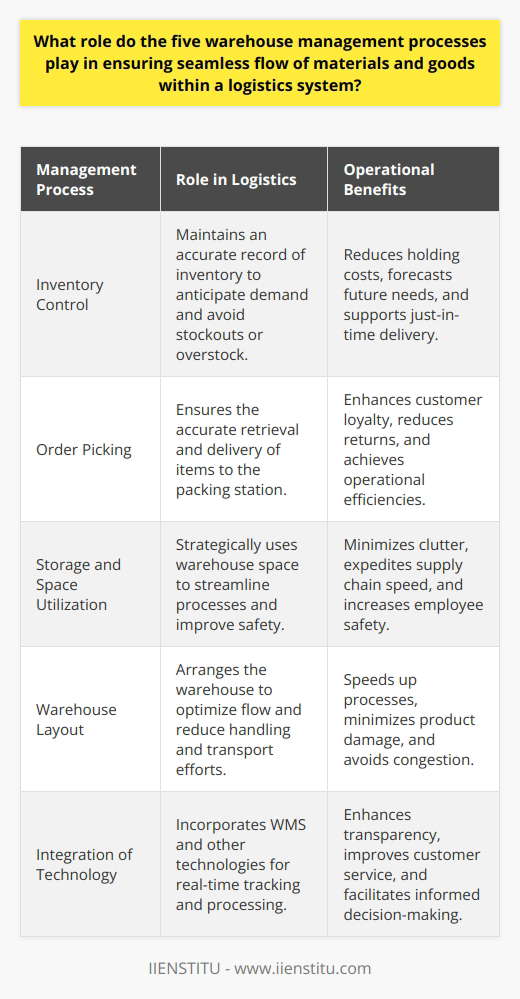
What is the role of storage and warehousing in logistics?
Role of Storage and Warehousing
Storage Element in Logistics
Storage is a crucial component of logistics, as it facilitates the process of holding goods and materials at secure locations until they are ready for distribution, assembly, or delivery. Through the careful preservation of inventories, businesses can maintain a continuous supply of products, ensuring that demand can be met promptly.
Warehousing Functions
Warehousing refers to the systems, facilities, and services that are necessary for the proper storage of products. It encompasses a variety of core functions, such as inventory management, order fulfillment, and materials handling. Warehouses offer a safe and controlled environment for products to be stored in optimal conditions, preventing damage or spoilage. Moreover, adopting advanced warehousing techniques, such as automated storage and retrieval systems, can optimize the efficiency of logistics operations.
Reducing Costs and Maximizing Profit
Efficient storage and warehousing solutions directly contribute to the profitability of a business. By minimizing handling times, reducing product damage, and ensuring on-time delivery, businesses can minimize costs and maximize profit. Additionally, a well-organized warehouse can manage its inventory levels more accurately, reducing the risk of holding excessive stock, which can lead to unnecessary costs and wasted resources.
Achieving Flexibility
Storage and warehousing strategies can enhance the flexibility of logistics operations, allowing businesses to adapt to fluctuations in demand more effectively. Through dynamic inventory management and just-in-time delivery mechanisms, warehouses can maintain an optimal level of stock, enabling businesses to respond to changing market conditions and customer needs. This flexibility is particularly valuable in volatile industries and for businesses that experience seasonal fluctuations in demand.
Enhancing Customer Satisfaction
An efficient storage and warehousing system is vital for meeting customer expectations regarding product availability and delivery times. By ensuring a seamless flow of products throughout the supply chain, effective storage and warehousing solutions can significantly contribute to enhancing customer satisfaction. This, in turn, leads to increased customer loyalty and repeat business, giving companies a competitive edge in the market.
In conclusion, storage and warehousing play pivotal roles in the logistics process. By optimizing storage facilities, embracing modern warehousing techniques, and managing inventory effectively, businesses can not only reduce costs and increase profits but also enhance flexibility and customer satisfaction. As such, focusing on storage and warehousing solutions should be considered an essential component of a successful logistics strategy.

What are the three approaches to warehouse management?
**Traditional Warehouse Management**
The first approach to warehouse management is traditional warehouse management, which focuses on the physical storage and handling of products within a facility. In this system, workers are responsible for managing inventory manually, using tools such as spreadsheets and handwritten logs. This method is most often used in smaller warehouses and requires extensive knowledge of the products and their locations within the facility.
**Warehouse Management Systems (WMS)**
A second approach to warehouse management involves the use of Warehouse Management Systems (WMS). These are software applications designed to automate various aspects of warehouse operations, including inventory tracking, order picking, and shipping. A WMS enables companies to maintain accurate inventory levels, optimize storage space usage, and increase overall efficiency while reducing labor costs. This approach is most often used in large warehouses and distribution centers, where automation can lead to significant improvements in operational efficiency and accuracy.
**Just-In-Time (JIT) Warehouse Management**
The Just-In-Time (JIT) approach to warehouse management is a strategy that aims to minimize inventory levels and reduce carrying costs. Under this approach, companies only store products in the warehouse for a short period before they are needed, sourcing items as they are demanded by customers. JIT relies on strong supplier relationships and accurate demand forecasting to ensure products are available when needed. This approach reduces storage space requirements and can improve cash flow, as companies do not need to maintain large stockpiles of inventory.

What are warehouse management systems in logistics?
Warehouse Management Systems in Logistics
Definition and Purpose
Warehouse management systems (WMS) are software applications that streamline logistics processes by automating the tracking, handling, and storage of goods in a warehouse. The primary purpose of these systems is to optimize efficiency, reduce errors, and simplify warehouse operations.
Functions and Features
These software systems offer essential features and functions for managing a warehouse, including inventory tracking and control, order management, and space optimization. Additionally, WMS incorporates demand forecasting, labor management, and reporting tools to enhance decision-making and resource allocation.
Integration with Other Systems
WMS solutions seamlessly integrate with other logistics and business systems, such as transportation management systems (TMS), enterprise resource planning (ERP), and customer relationship management (CRM) platforms. This integration allows for better communication and data-sharing across different departments, fostering cooperation and reducing redundancies.
Benefits of WMS
Implementing a warehouse management system can greatly benefit logistics companies by improving inventory control, reducing labor costs, and enhancing customer satisfaction. Better inventory management prevents stockouts and overstocks, leading to better overall warehouse efficiency. Automated processes reduce the need for manual labor, leading to lower labor costs. Additionally, real-time inventory data enables more accurate order fulfillment, leading to higher customer satisfaction and repeat business.
Challenges and Solutions
Despite its advantages, adopting a WMS can present challenges, such as high initial investment, potential employees' resistance to change, and compatibility issues with existing IT infrastructure. To address these challenges, companies should conduct thorough cost-benefit analyses and engage key stakeholders in the implementation process. Furthermore, selecting a scalable and adaptable WMS solution can alleviate compatibility issues and support the organization's growth.
In conclusion, warehouse management systems play a critical role in enhancing logistics operations by automating, optimizing, and simplifying warehouse processes. Its integration with other business systems and numerous benefits make it a valuable addition to any organization, though it is essential to consider and address potential challenges in implementation.

What is the system approach in logistics management?
System Approach in Logistics Management
Understanding the Concept
The system approach in logistics management refers to a holistic perspective of integrating and optimizing various elements within the supply chain. This approach is rooted in the fundamental principle of considering all components of the supply chain as interconnected and interdependent, which fosters improved decision-making and problem-solving.
Significance of System Approach
Adopting a system approach in logistics management leads to numerous benefits, including increased efficiency, cost savings, and enhanced adaptability. It allows organizations to effectively manage logistics activities and resources while mitigating potential risks and challenges. By doing so, the overall performance of logistics operations can be significantly improved.
Facilitation of Coordination
A primary advantage of the system approach is that it facilitates coordination among different logistics functions. By considering the interconnectedness of various elements in the supply chain, organizations can easily identify and address any bottlenecks or discrepancies, thereby ensuring smooth and seamless operations.
Promotion of Flexibility
The system approach also promotes flexibility in logistics management by encouraging proactive decision-making. As organizations become more adept at identifying potential challenges and promptly responding to them, they can adapt their logistics strategies more effectively. This adaptability allows them to cope with uncertainties and capitalize on emerging opportunities.
Optimization of Resources
Lastly, the system approach enables organizations to optimize the utilization of resources in their logistics operations. Through comprehensive analysis and evaluation of resource allocation and processes, organizations can minimize wastage and redundancies. This streamlined and efficient use of resources ultimately results in significant cost savings.
In conclusion, the system approach plays a crucial role in enhancing logistics management by fostering better coordination, promoting flexibility, and optimizing resource utilization. By adopting this holistic perspective, organizations can significantly improve their supply chain operations and achieve a competitive edge in today's dynamic business environment.
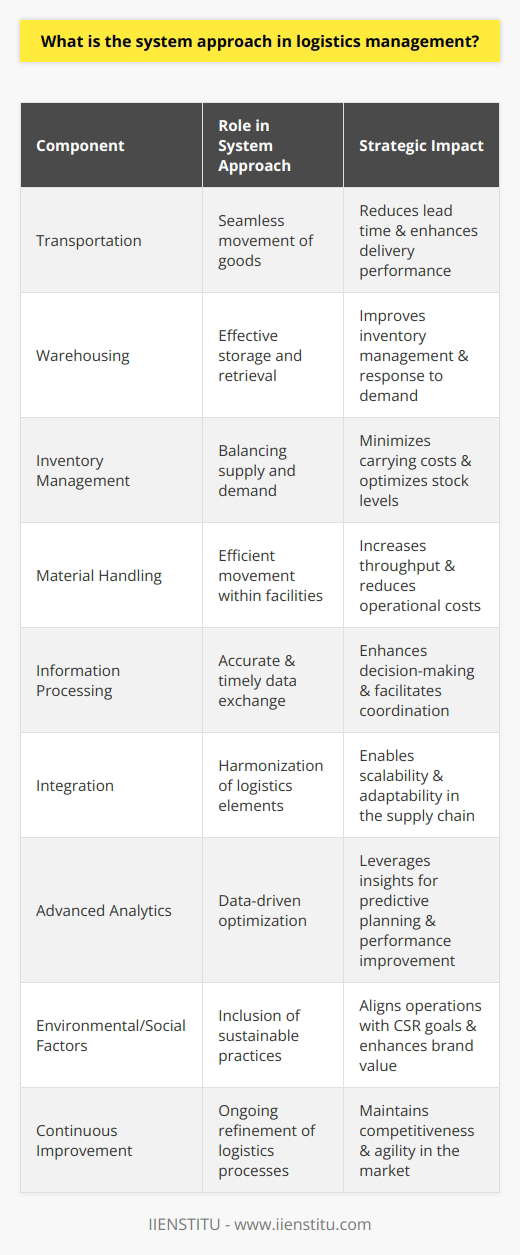
What are the key principles of effective warehouse management in the context of logistics?
Efficient Space Utilization
A primary principle of effective warehouse management is the optimal utilization of warehouse space. This involves the strategic organization of goods and materials in the most suitable manner that ensures efficient access and usage. Proper space management can lead to more streamlined operations, reduced labor costs, and better inventory control.
Inventory Accuracy
Another crucial aspect of warehouse management is maintaining accurate inventory records to ensure seamless operations and avoid product stock-outs or overstocks. Implementing regular inventory audits, cycle counts, and accurate record-keeping can help warehouse managers track stock levels and order statuses effectively. Additionally, incorporating technologies like barcoding systems and warehouse management software can contribute to improved inventory accuracy.
Order Fulfillment Efficiency
Efficient order fulfillment is essential for timely deliveries and improved customer satisfaction. Warehouse managers must establish processes that minimize order processing time and ensure goods are picked, packed, and dispatched quickly. Adopting strategies such as zone picking, wave picking, and batch picking can enhance order fulfillment efficiency and simplify labor-intensive processes.
Safety and Security Measures
Safety and security are of utmost importance in warehouse management. Implementing comprehensive safety precautions, including proper warehouse design, layout, and PPE usage, can significantly reduce workplace accidents and injuries. In terms of security, warehouse managers must establish proper access control mechanisms and deploy surveillance systems to prevent theft, vandalism, and protect valuable assets.
Continuous Improvement
Lastly, implementing a culture of continuous improvement ensures warehouse operations adapt to evolving industry demands and remain competitive in the logistics sector. Warehouse managers should regularly evaluate and analyze their operations to identify areas for improvement, assess the effectiveness of current strategies, and invest in the latest technology and automation solutions.
In conclusion, key principles of effective warehouse management include efficient space utilization, inventory accuracy, order fulfillment efficiency, safety and security measures, and continuous improvement. By adhering to these principles, warehouse managers can optimize their operations, enhance overall productivity, and contribute to their organization's logistic success.

How do warehouse management systems contribute to the overall efficiency of the logistics process?
Warehouse Management System Impact on Efficiency
A vital aspect of efficient logistics lies in an effective warehouse management system (WMS). The WMS streamlines the storage, management, and movement of products within a warehouse, ultimately improving the overall logistics process.
Improved Inventory Accuracy
Accurate inventory tracking is a key factor in maintaining efficiency. WMS enables real-time tracking of products, reducing the likelihood of inaccuracies and enabling effective decision-making in terms of stocking, reordering, and demand forecasting.
Optimization of Storage Space
Efficient use of warehouse space contributes to cost savings as well as overall productivity. WMS utilizes advanced algorithms which assign and track items to specific storage locations, thus improving space utilization and reducing wasted time and effort in locating products.
Automation of Processes
By automating manual tasks with barcoding, scanning, and radio-frequency identification (RFID) technologies, WMS increases efficiency and accuracy in processes such as order picking, packing, and shipping. This results in fewer errors, cutting down returns and order cancellations.
Enhanced Labor Management
WMS not only improves the warehouse process but also optimizes labor management. It allows managers to closely monitor employee performance, distribute workload evenly and identify areas for improvement. Furthermore, it provides real-time data on employee productivity, leading to more informed decisions and targeted training.
Reduced Order Fulfillment Time
Achieving timely order fulfillment is a primary objective for logistics organizations. A well-designed WMS reduces order cycle time by facilitating quick retrieval of goods and directing pickers through the most efficient storage locations. This reduces order processing time and enhances customer satisfaction.
Support for Compliance and Traceability
Maintaining compliance with regulations and ensuring product traceability are critical aspects in modern logistics. WMS supports these needs with features that record and track lot numbers, expiration dates, and other essential information. This helps in recalling products efficiently when required and providing necessary documentation for regulatory compliance.
In conclusion, warehouse management systems play a pivotal role in optimizing the overall logistics process. WMS not only improves inventory accuracy and space utilization but also ensures automated processes, better labor management, reduced order fulfillment times, and enhanced compliance. Investing in a suitable WMS significantly contributes to the effectiveness and competitiveness of a logistics organization.
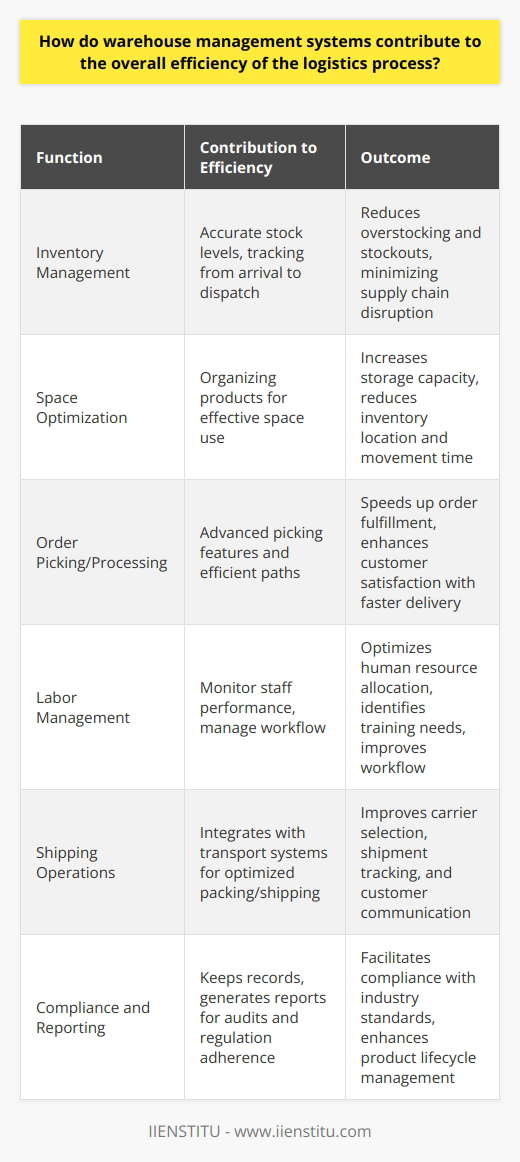
What are the core principles of a systems approach in optimizing logistics management?
Understanding the Principles
Broadly speaking, the three core principles of a systems approach in optimizing logistics management are holism, interrelationships, and perspectives.
Holism
Holism involves viewing logistics management as an integrated whole rather than a collection of individual components. In this approach, managers prioritize the overall performance and efficiency of the logistics system. This entails assessing objectives, capabilities, and capacity at a system-wide level.
Interrelationships
Interrelationships focus on the connections between different components of the logistics system. This principle highlights the importance of communication and coordination among various sectors. It also encourages a thorough understanding of how changes in one area can impact other areas. Coordinating shipping, transportation, and warehousing activities is an example of considering interrelationships for optimal results.
Perspectives
Different perspectives involve recognizing that stakeholders may have different views about the optimal operation of the logistics system. The various parties involved, whether they are suppliers, customers, or employees, may not hold the same priorities. Therefore, a systems approach balances these varied perspectives to ensure that the overall logistics management strategy meets multiple needs and expectations.
In summary, applying these principles in logistics management can improve the efficiency and performance of logistics processes. By considering the system as a whole, assessing interconnections, and balancing various perspectives, organizations can better optimize their logistics management for profitability and growth.
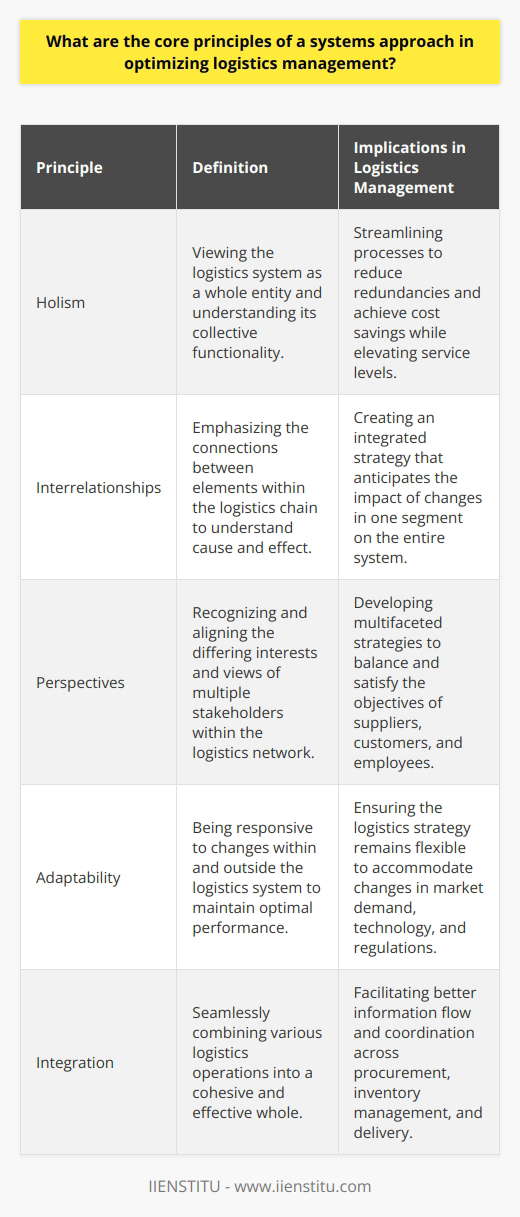
How do technological advancements impact the effectiveness of warehouse management systems in the logistics industry?
Improving Efficiency through Technology
Technological advancements transform warehouse management systems by improving their efficiency. Automation technology eradicates the need for manual labor, which reduces errors and boosts productivity. Complex tasks such as sorting, packaging and transporting of goods are completed faster with high accuracy using automated equipment.
Enhancing Inventory Management
The use of Radio Frequency Identification (RFID) and barcodes enhances inventory management. These technologies provide accurate, real-time information on inventory, preventing overstock or stock-out situations. It directly impacts order fulfilment by providing precise locations and quantities, streamlining the picking process. This dramatically cuts down on man-hours and logistical errors.
Leveraging Real-time Data for Forecasting
Advanced management systems utilize real-time data for predictive analytics and accurate forecasting. By gathering and analyzing data, warehouses can predict demand and prepare accordingly. This proactive approach to warehouse management decreases expenses and prevents wastage, while ensuring a steady supply of products.
Facilitating Order Tracking
Technological advancements facilitate comprehensive order tracking. Powered by GPS technology and advanced software, these systems provide real-time updates on products' locations and delivery statuses. This transparency enhances customer satisfaction as it enables receivers to track their orders from warehouse to doorstep.
Ensuring Safety and Security
Technological advancements contribute significantly to the safety and security of warehouses. Sophisticated surveillance systems and automated fire prevention technologies are examples of advancements that protect assets and employees.
In conclusion, technological advancements are a game-changer in the logistics industry, shaping a more efficient and reliable warehouse management system. They streamline processes, increase accuracy, enhance customer experience and ensure safety, proving their indispensability in a modern logistics landscape.

What are the primary objectives and functions of warehousing logistics within a supply chain?
Primary Objectives of Warehousing Logistics
Warehousing logistics holds pivotal roles in a supply chain. Firstly, its key objective is to facilitate storage. For a seamless operational cycle, companies must store commodities in optimal conditions until the moment of distribution.
Functions of Warehousing Logistics
A cardinal function is consolidation. Warehouses marshal goods from different sources and then dispatch them as a single consignment. This process diminishes shipping costs, rendering it a cost-effective solution. Another function, cross-docking, involves receiving goods and directly transferring them for onward dispatch, without redundant storage. This practice diminishes storage costs and reduces transportation time.
Warehousing Logistics for Value-added Services
Warehouses also perform value-added services. They engage in activities like packaging, ticketing, and labeling to bring extra value to commodities. These services can adapt products to specific requirements of a market.
Warehousing Logistics for Smooth Operations
Another crucial function of warehousing logistics is ensuring business continuity. In case of a disruption in the supply chain, a significant inventory in the warehouse can sustain operations. This mechanism helps in maintaining customer satisfaction.
Warehousing Logistics for Risk Management
Finally, warehouses play a significant part in risk management. By storing goods, they help control uncertainties of supply and demand. They secure inventory against theft, damage, and dilapidation, thereby diminishing operational risks.
In conclusion, warehousing logistics are integral to a supply chain. They ensure safe storage, streamline distributions, offer added value services, and help manage risk effectively. Hence, their valuable contributions augment operational efficiency and fortify the bottom line of businesses.
